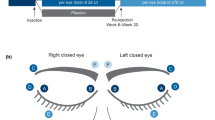Abstract
Botulinum neurotoxins (BoNTs) are the primary treatment for focal dystonias such as blepharospasm. Several different BoNT products are available in various countries. Given the variability in manufacturing, formulation, and unit doses of BoNTs, it is important to compare the profiles of products from different manufacturers. This double-blind, randomised, parallel-group pilot study compared the efficacy and safety of the BoNT type A product Xeomin® from Merz to BOTOX® from Allergan. Subjects (n = 65) were randomly assigned to receive one or the other BoNTA in a 1:1 proportion at a dose equal to that of their most recent treatment (≥20 U/eye). Symptoms were assessed on the Blepharospasm Disability Index (BSDI), Jankovic Rating Scale (JRS), and Patient Global Assessment (PGA) scale at 4 and 8 weeks. Both BoNTA products reduced scores on the BSDI and JRS (no statistically significant difference, tendency toward greater improvements with BOTOX® than Xeomin® at 4 and 8 weeks). A post hoc analysis showed a significantly greater number of BOTOX® treated patients reaching a responder threshold of 4 points on the total BSDI score and 0.67 points on the BSDI mean item score. No significant differences between products were noted in PGA and adverse events at the doses used in this study.


Similar content being viewed by others
References
Benecke R, Jost WH, Kanovsky P, Ruzicka E, Comes G, Grafe S (2005) A new botulinum toxin type A free of complexing proteins for treatment of cervical dystonia. Neurology 64:1949–1951
Brashear A (2008) Clinical comparisons of botulinum neurotoxin formulations. Neurologist 14:289–298
Brin MF, Jankovic J, Comella C, Blitzer A, Tsui JKC, Pullman SL (1995) Treatment of dystonia using botulinum toxin In: Kurlan R (ed) Treatment of movement disorders, Lippincott Company, New York, pp 183–246
Dressler D, Mander DJ, Fink K (2008) Equivalent potency of Xeomin® and BOTOX® Toxicon 51(Suppl 1):10
Epidemiological Study of Dystonia in Europe Collaborative Group (2000) A prevalence study of primary dystonia in eight European countries. J Neurol 247:787–792
European Medicines Agency (2005) Guideline on similar biological medicinal products. Available at: http://www.emea.europa.eu/pdfs/human/biosimilar/043704en.pdf. Accessed June 2, 2009
Frevert J (2010) Content of botulinum neurotoxin in botox®/vistabel®, dysport®/azzalure®, and xeomin®/bocouture® Drugs R D 10:67–73
Goertelmeyer S, Brinkmann G, Comes A, Delcker A (2002) The Blepharospasm Disability Index (BSDI) for the assessment of functional health in focal dystonia. Clin Neurophysiol 113:S77–S78
Hall TA, McGwin G Jr, Searcey K, Xie A, Hupp SL, Owsley C, Kline LB (2006) Health-related quality of life and psychosocial characteristics of patients with benign essential blepharospasm. Arch Ophthalmol 24:116–119
Hallett M, Daroff RB (1996) Blepharospasm: report of a workshop. Neurology 46:1213–1218
Hunt T, Clarke K (2009) Potency evaluation of a formulated drug product containing 150-kD botulinum neurotoxin type A. Clin Neuropharmacol 32:28–31
Jankovic J, Orman J (1987) Botulinum A toxin for cranial-cervical dystonia: a double-blind, placebo-controlled study. Neurology 37:616–623
Jankovic J, Kenney C, Grafe S, Goertelmeyer R, Comes G (2009) Relationship between various clinical outcome assessments in patients with blepharospasm. Mov Disord 24:407–413
Jost WH, Kohl A (2001) Botulinum toxin: evidence-based medicine criteria in blepharospasm and hemifacial spasm. J Neurol 248(Suppl 1):21–24
Pekmezovic T, Svetel M, Ivanovic N, Dragasevic N, Petrovic I, Tepavcevic DK, Kostic VS (2009) Quality of life in patients with focal dystonia. Clin Neurol Neurosurg 111:161–164
Roggenkamper P, Jost WH, Bihari K, Comes G, Grafe S (2006) Efficacy and safety of a new botulinum toxin type A free of complexing proteins in the treatment of blepharospasm. J Neural Transm 113:303–312
Scott AB, Kennedy RA, Stubbs HA (1985) Botulinum A toxin injection as a treatment for blepharospasm. Arch Ophthalmol 103:347–350
Simpson LL (1981) The origin, structure, and pharmacological activity of botulinum toxin. Pharmacol Rev 33:155–188
Wabbels B, Jost WH, Roggenkämper P (2010) Difficulties with differentiating botulinum toxin treatment effects in essential blepharospasm. J Neural Trans (to be submitted)
Acknowledgments
Subjects in this study were recruited from three study centers in Germany: University of Bonn (Prof. Dr. Peter Roggenkämper, PD Dr. Bettina Wabbels), Paracelsus-Klinik in Zwickau (Prof. Gerhard Reichel), and Deutsche Klinik für Diagnostik in Wiesbaden (Prof. Wolfgang H Jost). The authors acknowledge the assistance of Mary Ann Chapman, PhD, in the preparation of this manuscript.
Conflict of interest
This study was sponsored by Allergan, Inc.
Author information
Authors and Affiliations
Corresponding author
Rights and permissions
About this article
Cite this article
Wabbels, B., Reichel, G., Fulford-Smith, A. et al. Double-blind, randomised, parallel group pilot study comparing two botulinum toxin type A products for the treatment of blepharospasm. J Neural Transm 118, 233–239 (2011). https://doi.org/10.1007/s00702-010-0529-x
Received:
Accepted:
Published:
Issue Date:
DOI: https://doi.org/10.1007/s00702-010-0529-x




